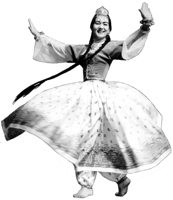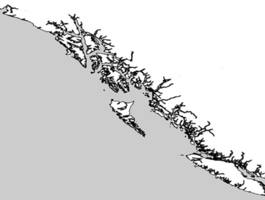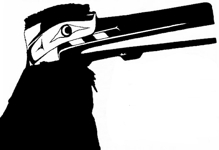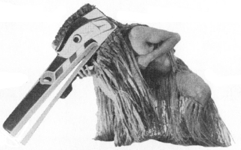
|
The Society of Folk Dance Historians (SFDH)
Kwakiutl Dance Theatre
[
Home |
About |
Encyclopedia | CLICK AN IMAGE TO ENLARGE |

|
 The Kwakiutl, or Kwakwaka’wakw, are one of the principal tribes inhabiting the part of the Northwest Pacific coast that extends upwards from Puget Sound into Southeastern Alaska. Their first known contact with the Europeans took place in the 1770s, when English and Spanish explorers were charting the southern coast. The principal aim of these explorers was to establish Crown claims, but the chief interest of the sea-captains who followed them was the fur trade.
The Kwakiutl, or Kwakwaka’wakw, are one of the principal tribes inhabiting the part of the Northwest Pacific coast that extends upwards from Puget Sound into Southeastern Alaska. Their first known contact with the Europeans took place in the 1770s, when English and Spanish explorers were charting the southern coast. The principal aim of these explorers was to establish Crown claims, but the chief interest of the sea-captains who followed them was the fur trade.
 The relationship between the traders and tribesmen was relatively amicable, and because of the exchange trade-goods, particularly steel tools, created a period of great prosperity and cultural progress that lasted until the near-extinction of the sea-otter and other valuable fur-bearing animals.
The relationship between the traders and tribesmen was relatively amicable, and because of the exchange trade-goods, particularly steel tools, created a period of great prosperity and cultural progress that lasted until the near-extinction of the sea-otter and other valuable fur-bearing animals.
As the 19th century brought more and more settlers to the West Coast, the condition of the tribal peoples gradually changed for the worse, but because their rugged environment was unsuitable for agriculture, they did not experience the displacement suffered by so many other Native Americans. However, in the half-century or more that spanned the last of the 19th century and the first part of the 20th, a combination of factors reduced the indigenous population drastically. The chief cause was imported diseases against which the indegenes had no immunity. For those who survived, there was the loss of self-esteem, so vital in this culture, that resulted from the Canadian Government's Act of 1884 outlawing tribal ceremonies, particularly the Potlatch, an opulent ceremonial feast at which possessions were given away or destroyed to display wealth or enhance prestige.
Although these ceremonies were carried on clandestinely, police raids and confiscation of valuable masks constituted a continuing harassment. It was not until 1951, when the repressive Act of 1884 was finally abolished that the renaissance of Northwest art could rightfully begin. The Canadian Government had so completely reversed their previous policy that they then encouraged indigenous arts with generous financial support.
Today, wealthy fishermen, proud of their cultural heritage, are again giving Potlatches and commissioning artists to carve great poles and create new masks to replace the many works of art that have disappeared into museum collections all over the world.
MYTHOLOGY AND RITUAL
Because sea-farers and fisher-folk, like nomadic and hunting societies, do not practice agriculture or horticulture, their mythologies rarely develop anything resembling fertility rites, and sexual symbolism plays a minimal role in their iconography. In cultures here living dangerously is the norm, courage and self-discipline are exalted, and both mythology and ceremonial rites tend to be concerned with bravery and ordeals. In the Northwest these included endurance of pain and hardship, mortification of the flesh, and possibly necrotic rites.
The Winter Ceremonial is, on one level, the celebration of such ordeals. The ceremonial itself is called "Tseyka," which means "fraudulent" in the Kwakiutl language. This is in acknowledgement of the audience's acceptance that what they are about to experience is theatre, not reality. Some of the legends are from long ago, and others are about spirits and creatures that still inhabit the forest gloom. The central character in the drama is the "Hamatsa," the initiate who has been away in the house of the "Bakbakwalanooksiway," the Cannibal at the End of the World. This legend is somewhat akin to the Prometheus myth with Dionysian overtones: a mortal who has spent weeks in the forest undergoing terrifying ordeals and lonely vigils acquires the powers of the immortal spirits. The power, like fire, must be tamed before it can be useful and no longer dangerous or destructive. This is the central myth, the theme of miraculous disappearance and re-appearance, around which all other legends are woven.
THEATRE, PRODUCTEION, AND PERFORMANCE
The season of dramatic dance presentations, with the attendant Potlatch, took place in great dance-houses of hewn planks forty or fifty feet high, and eighty or ninety feet long. These buildings were carefully fitted out for the performances and the striking theatrical effects contrived for these spectacles included the use of speaking-tubes for the production of disembodied voices and devices for effecting "magical" appearances and disappearances.
A back-drop curtain, the "mawihl," screened off the "backstage" area from which many of the performers entered and exited. This large curtain was painted with a design representing the spirit of the dance house, usually some fabulous creature like the "sisiutl," a dragon-like two-headed serpent.
The in-the-round performance situation was ideal for audience participation. The lighting provided by the central fire gave the effect of foot-lighting and overhead lighting was achieved by manipulating the moveable planks of the roof. The dramatic interplay of warm and cool color gave striking dimension to the masks of the dancers as they moved through these contrasting lights.
Because the Winter Ceremonial took place over a period of many weeks, and certain of its events occurred out-of-doors, in the daytime and on the beach, even on or in the water, these presentations involved a major commitment of time for the entire community.
For the production of the performances, the village was divided into two groups: the dance societies and the audience. The dance societies themselves were subdivided into managers and performers. Only those performers who had already been initiated could take part in the major ceremonial (which included the Hamatsa ritual), but in actual practice the so-called minor ceremonial was not kept separate. Enthusiasm among these lesser performers ran high, and all the little groups put together their various skits in great secrecy so that "opening night" would create a proper sensation. If a new skit was a "hit," it became part of the standard repertoire; if it was not well received, it was never heard of again.
Not only was there a vast variety of dances, but choreographies and stagings were frequently re-arranged; individual dances eliminated and new ones introduced so that no two ceremonials ever really followed the same pattern. The laissez-faire character of these performances often resembled commedia dell'arte (an early form of professional theatre originating from Italy) more than any rigid or stylized theatrical or ritual. In fact, among the Southern Kwakiutl, there was often only a single society that included a hodgepodge of both "Tseyka" (shaman's society) and "Tlasula" (retuned-from-heaven society) ceremonials while portraying these parallel myths.
DANCE AS AN EXPRESSION OF STATUS, WEALTH, AND PRIVILEGE
The Potlatch was an essential part of the winter's festivities. Its name derives from the Chinook word "to give," a concept that is central not only to the winter ceremonial itself, but the the entire social structure of the Kwakiutl. The Potlatch was an all-encompassing event that combined the witnessing of a sacred ritual, and the attendant gifts that validated it, with feasting, speech-making, singing, clowning, and a display and distribution of property intended to put all rivals to shame.
The instinct of ownership and exclusivity among animals seldom extends much beyond food, territory, and mate selection; but most human societies have extended these basics to include chattels of all kinds. Among the Northwest tribes, the acquisition and disposition of property and privileges became the most important social imperative, and the Potlatch, with its largesse and conspicuous consumption, is the ultimate expression of this ethos.
Transference of privilege was primarily through inheritance, an important implementation of which was the dowry; and the jealously guarded songs and dances, along with the paraphernalia, sometimes constituted a not inconsiderable portion of such transferences; thus appropriation of such prerogatives was in the nature of theft. And, because of outright theft, sometimes involving murder, was not unheard of, presenting a song or dance as a gift was often a sensible way of preventing a raiding party from taking a canoe-load of masks by force.
Borrowing, actually appropriating, was also fairly common. The "Kwekwe" dance was borrowed from the Salish tribe and introduced as a divertissement in the Tseyka; and "Comox" songs were sung by the Kwakiutl, supposedly in the Comox language. New songs and dances were constantly being created, either "dreamed" by an individual for his or her own performance or commissioned by chiefs who employed bards in the same way that they employed carvers fo the production of heraldic crest poles, masks, and other works of art. In a society based on slave labor as this one was, professional artists as well as shaman-healers and warriors could be supported.
Masked dances were of two principal kinds: animal dances and character dances. The latter, with the exception of ancestor dances, usually represented supernatural beings of one kind or another. Animal dances can be subdivided into two main groupings: mimetic (usually naturalistic solo performances) and formalized clan or society dances. The first kind usually employed full masks, often with movable parts, and complete costumes of fur or feathers. In these dances, a single bird, beast, or insect is portrayed by an individual dancer whose miming skill can convincingly evoke the creature represented. Society and clan dances, on the other hand, were performed in large groups, with all participants wearing identical regalia and performing the same movements. The masks worn for these dances were usually of the forehead kind which did not hide the face of the wearer. The movements of these dances were often both limited in scope and highly repetitive.
An interesting dance that combined features of both these categories was the "Atlakem," a dance about an ancestor who came upon a glade in the forest where all the creatures were dancing.
 Probably the most famous of all the masked dances are those of the "Cannibal Birds" in the Tseyka cycle. These great masks, carved from cedar, beautifully designed and painted, were equipped with movable beaks that clacked ominously as the dancers lifted their knees high in bird-like hoppings and foragings on an imaginary beach. "Kwakwakhwalanooksiwey," the Cannibal Raven; "Galkwudzuwis," the Crooken-Beak of Heaven; and "Hohokw," who breaks men's skulls with his great beak; these were the terrifying companions of the Hamatsa.
Probably the most famous of all the masked dances are those of the "Cannibal Birds" in the Tseyka cycle. These great masks, carved from cedar, beautifully designed and painted, were equipped with movable beaks that clacked ominously as the dancers lifted their knees high in bird-like hoppings and foragings on an imaginary beach. "Kwakwakhwalanooksiwey," the Cannibal Raven; "Galkwudzuwis," the Crooken-Beak of Heaven; and "Hohokw," who breaks men's skulls with his great beak; these were the terrifying companions of the Hamatsa.
The most spectacular masks of all are the "transformation masks" with which the ancestor dancers told their lineage history in movement, and as a fitting climax, revealed the legendary bird or beast in human form.
Besides these, there are a great number of other masked dances that parade characters running the gamut from ogres and ogresses like "Bukwus" and "Dzonoqwa" to objects and forces of nature like the sun, moon, echo, and earthquake (borrowed from the Selish tribe).
In the Tlasula cycle, which is performed in the spring, the theme of disappearance and re-appearance is repeated, but with an entirely different cast of characters, different kinds of whistles and rattles, and different legends. the Tlasula cycle provides perhaps the single most beautiful Kwakiutl dance, the "Ermine Dance." Also called "Feather Dance" and "Peace Dance," it takes its best-known designation from the great mantle of ermines that descend from the "amhalayt" (chief's headdress). This elegant headdress is fronted with a small, finely carved ornament, and inlaid with shining blue-green "haliotis" (abalone shell) and surmounted by a spikey crown of sea-lion whiskers to hold eagle-down.
The "amhalayt," the Chilkat tribe's cloak, and aprons worn for this dance were traditional chiefs' regalia. The striking black, white, blue-green, and yellow patterns of the Chilkat cloak were woven with mountain goats' hair and bordered with a deep fringe that swept in graceful curves as the dancer turned and whirled. Special movements in the dance caused the eagle-down to waft from the amhalayt, and if there were several dancers, could create a veritable snow-storm.
Eighteenth-century Spanish drawings of the Nootka tribe show members of both sexes in costumes of finely-shredded cedar-bark and goats' hair fabric, trimmed with velvety sea-otter fur, and wearing a multitude of handsome ornaments made of dentalium (tooth shells or tusk shells), silver, haliotis, and copper. The men wore a spruce-root basketry hat, that with variations of shape and ornamentation was worn by tribes from the southern Nootka tribe to the northern Tlingit tribe. But a few drawings portray men wearing no more than a wide-brimmed hat and a fur mantle. A 19th century artist, Paul Kane, painted a scene of masked dancers in which one dancer wears a Chilkat cloak, and the rest wear masks and little else. At the present time, the Cannibal Birds still wear only shredded-bark fringe, and the Hamatsa secret society makes his initial entrance clad in nothing but hemlock twigs, and his final appearance in cedar-bark. Even the female dancer, as in the "Tugwid" (dancing song), wore only hemlock boughs.
Theatrical face and body painting of various sorts was used;l sometimes of a very simple kind, like the solidly blackened face of the Hamatsa, and sometimes as highly ornamental as the designs on some of the portrait masks.
Most of the dancers wore elaborate and richly adorned costumes of a fashion that had become fairly standard throughout the Northwest. It consisted of a dance-shirt, dance aprons (front and back), leggings, and button-blanket; the latter made from Hudson's Bay blankets (usually dare blue) bordered and appliqued with red cloth and ornamented with hundreds of mother-of-pearl buttons. This costume had gradually replaced the cedar-bark and pelt clothing of the earlier period.
The gradual blurring of tribal lines indicated by this development in costume was paralleled by the diffusion of individual dances through inter-tribal marriages. Dance styles, like the region's iconography, are difficult to isolate from the overall cultural pattern, and individualistic expression, as in carving and painting, sometimes transcends tribal boundaries. This problem in describing Kwakiutl dancing is equalled by the difficulties that arise from attempts to categorize dances as either male or female. While there are stylistic devices that are used only by men and others only by women, dance styles are more usefully grouped into areas appropriate to a complex of dances, such as shamanistic dances, in which the style of the female Tugwid, for example, does not differ from that of a male shaman.
Typically feminine dancing is very graceful, and is expected to exert a calming and subduing effect on wild creatures. Even the anger of a powerful chief may be averted by such dancing. Naida's Dance of Life and Death in the Edward S. Curtis film, "Land of the Head Hunters," is a beautiful example of this style, and the "Nan'e" (grizzly bear dance-song) shows this kind of movement in a company of dancers. There is a common misconception about the use of the arms in this feminine style, the impression that the upper arms are held tightly against the torso. While the elbows do not move totally away from the body, they always provide the delicate movements of the forearms and hands with supple support. The body is typically (but not always) bent forward slightly at the hips, as in much of Kwakiutl dancing, and the shoulders are delicately rounded in the manner that distinguishes most Northwest dancing. The steps and pauses to the syncopated rhythm create a gentle rising and falling that, even in the bendings and turnings, suggests sea-birds floating and bobbing on the waves.
DANCE AS POWER
Both good and evil forces are personified in these dances; and in the masked dances, permanently identified with the mask-character. "Bukwus," an ogre of the forest, enticed the spirits of the drowned. He tried to make people eat ghost-food so that they would remain forever in the unreal forest in which he dwelt. His dance is both exciting and malevolent. "Dzonoqwa," the ogress of the wood, is also the "sleeping one" who moves around the fire in the wrong direction, as well as the witch who eats little children. Her mask can also symbolize wealth, and her dance is full of ambiguities.
The role of the Hamatisa-initiate provides the most important dancing because of his central position in the great myth, and his many appearances and re-appearances throughout the duration of the Winter Ceremonial. His dances vary greatly: from violent leaping, somersaulting, squatting, fierce darting attacks, to the demeanor of a tractable beast led back to the world of humans by a female companion, one moment dashing around the fire with high knee-lifts, the next instant struggling with his captors and trying to throw himself into the fire, shaking and trembling.
Power dances embrace a wide range of dance that have to do with healing, magic, and the spirit. These are all "trembling" dances, and while in some the trembling may be expressed by the hands alone, in others the entire body and all the extremities are involved. The flexing of the arch in these dances (which are almost always performed on half-toe) is a heightened development of the knee-flexes that distinguish most of the other dances, and mark the cadence in some of the songs when the singer stands in one place. Some of these dances are sedate as the gesturing, knee-flexing "Copper Dance," in which speech-making is perhaps the most important element.
The wide distribution of this characteristic knee-flexing movement relates to this basic dance element not only to other American cultures, and to the Eskimo, but to Asiatic shamanistic dancing, and especially to such dances as those of the Balinese ogre, "Djouk," and the ogress, "Rangda."
The musical accompaniment for the dancers was capable of a great range of dynamics: from a single dancer singing his or her own song, to a full chorus of all the men and women present. The deep and powerful voices of the men, who, with batons beating the accelerating rhythms on a long plank drum, would bring the song to a climax with a shout. There were huge wooden drums with the sound of thunder; hissing rattles; rattles with a sharp cracking noise; frame drums and whistles of many kinds; deep-toned, shrill, multi-pitched, and even some with beating reeds. The episodic nature of the performances, with their alternation of moods and dynamics, was admirably served by the capabilities of the human voice and the scope of these instruments. This mood-creation was most dramatically demonstrated by the ominous whistling that heralded the presence of the Hamatsa.
Comic dances and interludes usually consisted of broad clowning, and the performers wore humorous masks, often with comical details, such as the movable noses of the "Fool Dancers." All of these activities were essential components within both the Tseyka and Tlasula cycles, because they either advanced the progress of the mythological presentation itself, or provided a diversion.
Magical acts were an integral part of all these performances. They could be as simple as a sleight-of-hand substitution, or as complicated as a disappearance into the fire, and a subsequent resurrection at some distant place in the dance-house. The ingenuity of the Kwakiutl in devising startling theatrical effects has long been a source of admiration, and this quintessentially Asiatic approach to theatre is what makes the Northwest culture more closely akin to the dance theatre of the Far East than to other American cultures. A haunting question arises as to how much this culture echoes what pre-Columbian Mexican and Central American dance-theatre might have been like.
DOCUMENT
- Native American, an ethnic classification.
Used with permission of the author.
Printed in Folk Dance Scene, September 1980.
This page © 2018 by Ron Houston.
Please do not copy any part of this page without including this copyright notice.
Please do not copy small portions out of context.
Please do not copy large portions without permission from Ron Houston.